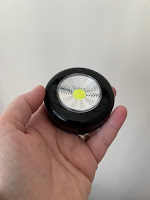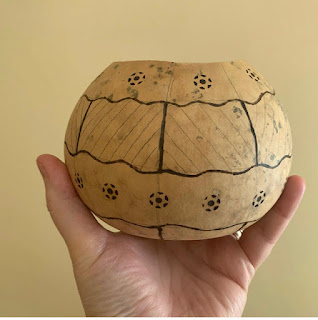If you live in the UK I cannot imagine that you have missed all the kerfuffle about some supermarket Caterpillar cakes.
I say we should embrace ALL of the caterpillars, so I have made a cuddly one that you can keep forever. He won't melt, go mouldy, make the kids sick..... he's just completely huggable.
I used Stylecraft Special DK yarn in Dark Brown, with scraps of cream for the face and feet, and tiny scraps of whatever colours for the sweeties on the top.
You can stuff him with regular toy stuffing, but I used some wadding that came in one of those monthly food boxes, I rolled it into a tight roll and it worked well.
So, here is the pattern for you. Enjoy :)
Stitches
explained:
Chain Stitch
(CH)- Yarn around hook (from the back) and pull the new yarn through the loop
on your hook. This is ONE chain. Repeat as needed.
Double Crochet
(DC) Put hook through work and draw yarn back through (2 loops on hook) yarn
around hook, draw through 2 loops on hook.
Half Treble
Crochet (HTR) Yarn around hook (from the back) put hook through work
and draw yarn back through (3 loops on hook) yarn around hook, draw through 3
loops on hook.
Treble Crochet
(TR)- Yarn around hook (from the back) put hook through work and draw yarn back
through (3 loops on hook) yarn around hook, draw through 2 loops on hook, yarn
around hook, draw through 2 loops on hook.
Double Treble
Crochet (DTR)- Yarn around hook twice (from the back) put hook through
work and draw yarn back through (4 loops on hook) yarn around hook, draw
through 2 loops on hook (3 times).
Slip Stitch
(SS)- Put hook through work and pull yarn through both work and stitch on your
hoo
Special Stitches
explained:
Front Post Double
Crochet (DC) Put hook around the stitch, bringing the hook back
to the front and finish the DC as normal.
BODY
(Brown)
Round 1. 6 DC into a Magic Ring. OR…. CH 2, then work 6 x DC's into the
2nd CH from your hook. (6 st) Pull up a
length of scrap yarn into the last stitch (to use as a stitch marker)
Round 2. Work 2 x DC's into EACH of the 6
stitches (12 st) Pull the scrap yarn up through the last
stitch. DO THIS AT THE END OF
EVERY ROW TO MARK YOUR PLACE.
Round 3. (DC 1 into next stitch, 2 x DC's
into the next) Repeat all the way around (18 st)
Round 4. (DC 1 into next 2 stitches, 2 x DC's
into the next) Repeat all the way around (24 st)
Round 5. (DC 1 into next 3 stitches, 2 x DC's
into the next) Repeat all the way around (30 st)
Round 6. (DC 1 into next 4 stitches, 2 x DC's
into the next) Repeat all the way around (36 st)
Round 7. (DC 1 into next 5 stitches, 2 x DC's
into the next) Repeat all the way around (42 st)
Round 8. (DC 1 into next 6 stitches, 2 x DC's
into the next) Repeat all the way around (48 st)
Round 9. (DC 1 into next 7 stitches, 2 x DC's
into the next) Repeat all the way around (56 st)
Round 10. Working into the BACK LOOPS of the
stitch only, DC into every stitch. (56 st)
Round 11-15. For 5 more rows - working into the FULL
STITCH, DC into every stitch. (56 st)
Round 16-19. For 4 rows – Work a DC front post
stitch (56 st)
Round 20-25. For 6 rows – (back to working a
regular DC) DC into every stitch. (56 st)
Round 26-29. For 4 rows – Work a DC front post
stitch (56 st)
Round 30-35. For 6 rows – (back to working a
regular DC) DC into every stitch. (56 st)
Round 36-39. For 4 rows – Work a DC front post
stitch (56 st)
Round 40-45. For 6 rows – (back to working a
regular DC) DC into every stitch. (56 st)
Round 46-49. For 4 rows – Work a DC front post
stitch (56 st)
Round 50-55. For 6 rows – (back to working a
regular DC) DC into every stitch. (56 st)
Round 56-59. For 4 rows – Work a DC front post
stitch (56 st)
Round 60-65. For 6 rows – (back to working a
regular DC) DC into every stitch. (56 st)
SS into the next
stitch, end yarn leaving a long tail for sewing up, remove marker.
BUM
END (Brown)
Work Rounds 1-9 from the body, (56 st) SS into the
next stitch and end yarn.
FACE (Cream)
Work Rounds 1-8 from the body, (48 st) ... carry on straight away from this stitch to shape the ears..
Ch 1, (TR, DTR, TR, HTR) in the next stitch, DC in next, SS in next 3, DC in next, (HTR, TR, DTR, TR, HTR) in next, DC in next, SS in next and end yarn. Leave a long
tail for sewing.
EYES (Brown – make 2)
Work Rounds 1-2 from the body, (12 st) SS into the
next stitch and end yarn. Leave a long
tail for sewing.
TONGUE (Pink)
Round 1. (DC, TR, HTR, DTR, TR, HTR, DC) into a Magic Ring. OR…. CH 2, then work (DC, TR, HTR, DTR,
TR, HTR, DC) into the 2nd CH from your hook. (7 st) SS into the first stitch, end yarn. Leave a
tail for sewing.
SWEETIES
(Mixed colours – make 10)
Round 1. 8 HTR into a Magic Ring. OR…. CH 2, then work 8 x HTR's into the
2nd CH from your hook. (8 st) ) SS
into the first stitch, end yarn. Leave a tail for sewing.
FEET (Cream – make 6)
Row 1. CH 5, DC into the 3rd CH from the hook, DC 2 (4 st)
TURN
Row 2-4. For 3 rows - CH 1, DC 4 (4 st) TURN
Row 5. CH 4, DC into the 3rd CH
from the hook, DC into the next st, then DC 4 across the main piece (7 st) TURN
Row 6-8. For 3 rows - CH 1, DC 7 (7 st) TURN
ASSEMBLY
Stuff your tube,
then using the BACK LOOPS only sew your Bum End in place at the bottom of the
tube.
Sew your eye and
tongue onto the face, then sew the face onto the end of your tube.
Position the feet
so that they touch the surface, then sew them in place, three on each side.
Sew the sweeties on
as shown in the photo.
I hope you have enjoyed making this caterpillar...I am not on anyone's side in this debate and I think all Caterpillars should just learn to get along and live with each other :)
Send me a photo if you make one, would love to see it :)





























































